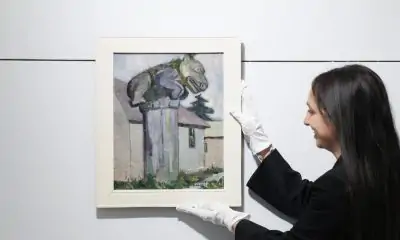Art
Japanese porcelain was his late wife’s legacy. Getting it all in a museum is his last mission in life
Probably the best way to begin this story is by noting that porcelain is strong and resilient but also breakable. It has a slightly human feel that way. Porcelain was arguably the first global fad. Chinese potters invented it in the seventh century A.D. They kept the formula – rare white clay known as kaolin mixed with feldsparic rock, baked in kilns at then-unheard-of temperatures of more than 1,300 degrees, to create a delicate white translucent skin that could nevertheless hold boiling water for tea – secret from the rest of the world for nearly a thousand years. Excellent secret keepers, the ancient Chinese.
Potters in Japan had been making ceramics of their own for five millenniums when they finally got their mucky hands on the porcelain recipe in the early 1600s. One result was the delicate, colourful product known as kakiemon porcelain, which proceeded to obsess the world for another two centuries.
In 1985, Molly Anne Macdonald, a former family therapist turned volunteer at the newly opened Gardiner Museum in Toronto, began to collect kakiemon with her husband, Bill. The couple were in Japan – a country they eventually spent more than a year in, over multiple visits, because Bill, a Toronto tax lawyer, was advising the Honda Engine Company. (He had a growing reputation as a policy wonk and political influencer, having backed his pal John Turner as leader of the Liberals.) Over the ensuing decades, before Molly Anne died of complications from a stroke in 2020, the couple collected more than 300 pieces of 17th-century Japanese, or Japanese-inspired, pottery.
Molly Anne’s portrait hangs behind Bill at the apartment that still holds some of their most valuable kakiemon items.Fred Lum/The Globe and Mail
In 2002, when they downsized to a modest condo, the Gardiner asked the Macdonalds if they’d leave their porcelain collection to the museum. They said yes.
Normally, a negotiation between a donor and a museum takes place over many years and is a secret and delicate affair, one in which the intense but narrow passion of the collector is played off against the broader and more complicated needs of the museum. But that’s not how Willie Mac rolls these days.
Instead, one sunny day this fall, Bill Macdonald is perched in a wheelchair in the aforementioned condo, urging a reporter to write about his campaign to convince the Gardiner to display the entire Macdonald porcelain collection, possibly in perpetuity. (Some of it is already on display in a small wing of the museum; most of the rest is in the museum’s vault.)
Macdonald also wants the museum to convince a corporate donor to spend a million dollars to tour the best pieces of the collection around the world. He wants a lecture series and a related residency for contemporary artists. A legacy, in other words, is always a story. It’s rarely a simple one.
Alas, on the sunny day in question, the future display of the Macdonald collection, to say nothing of who is going to pay for it, is still way up in the air, which is why the museum would rather Bill Macdonald not be talking to a reporter.
Bill Macdonald is famous for his (often self-promoting) persistence. Any number of journalists have been invited to lunch by Macdonald, only to find a raft of policy papers on their doorsteps, all penned by Macdonald, as prelunch reading material. But this latest push is fuelled by a fresh level of urgency, even for Bill Macdonald. He’s 95. He’s been sick. Time is running out. He has no intention of being left on a shelf.
As the end of his life approaches on not so nimble feet, Bill Macdonald’s most reliable legacy – after 70 years of supremely confident, crisply educated, vigorously rational, top-of-the-patriarchy white guy engagement in a country he has loved with a fervour, and even helped shape – turns out to be the eccentric 17th-century Japanese objets his wife wanted to collect.
At 95, Bill says he’s ‘not sure how many days I have left,’ making him all the more committed to getting the full porcelain collection displayed at the Gardiner.Fred Lum/The Globe and Mail
A picture of Molly Anne sits at the dining table. There is another on the wall at the foot of his bed.Fred Lum/The Globe and Mail
“I had an ear infection” he says, without wasting time to say hello, as his caregiver/assistant/saviour Rochelle rolls his wheelchair up to the apartment’s dining room table. The apartment looks south, over a graveyard in the foreground and the city’s downtown in the distance. He spends most days in bed now, having lost the use of his legs to neuropathy. “Five days, gone, just removed from my life. I don’t remember any of it. People who saw me say I was crazy.” People who saw him say it lasted a lot longer than five days. His skin is a yellowed grey. A shock of hair, shaved short at the sides but slightly longer on top – still showing brown! – stands off his head like a crown of permanent surprise. “I’m not sure,” he adds, “how many days I have left.” Pause, possibly for effect. “Not many.”
A three-foot-high black-and-white photograph of Molly Anne, his late wife, faces him from a chair at the far end of the dining table. (A larger Istvan Nyikos portrait of her adorns the wall at the foot of his bed in the next room. He likes to keep her in view.)
Before Molly Anne retired as a family therapist in 1985, her day began – because family therapy was practised in the evening, when the whole family could be present – as Bill’s ended. Collecting was a pastime they could do together.
“She was the reason all this happened,” he says, his voice so faint it is barely audible. He has, by long habit, ordered lunch in from the York Club, a members-only establishment some kilometres away – an omelette for the reporter, half a dozen oysters for himself. But he can’t raise his arms much any more, so each oyster requires a yelped “Rochelle!”, who then returns to slip a mollusk into his mouth. Then she leaves again.
Suddenly, in a faint, almost awe-filled voice, Macdonald says, “I have to sneeze!” He holds the explosion in, to a muffled snort. It is not immediately clear he will survive the ordeal.
Time and aging! Even titans are laid low. With Rochelle’s help, he begins the fetching of the documents, the impressive proof of a life lived with good intentions: his CV, pages long and packed with accomplishments; essays he has written and is writing (he’s still writing, and still buying kakiemon); the three books he and Molly Anne published about their porcelain; even a copy of a letter designating the ceremonial First Nations name, Thlakna-Wren, bestowed on Macdonald by Shawn Atleo in honour of Macdonald’s counsel, a massive honour. But – this is the surprise – none of it gets him going any more the way the porcelain does. “Outside of my career,” he says, and it sounds like a welcome revelation, “everything that matters to me came from Molly Anne.”
By the end of the 1600s, Japanese potters were producing the finest porcelain in the world from the kaolin they found near Arita, on Kyushu, Japan’s southernmost island. Still, their wares might never have dented China’s global porcelain monopoly had the Ming Dynasty not succumbed in 1644 to the Manchurian warlords who kicked off the Qing dynasty. To quell a popular uprising, the new rulers of China cut off its trade with the outside world, whereupon the Dutch East India company turned to Japan for porcelain. Early capitalism was no different from our modern version.
At first the Japanese simply copied the blue-and-white Chinese designs that sold so well in Europe. But their own aesthetic quickly emerged, on smaller and more intimate dishes used in the Zen Buddhist tea ceremonies that were becoming popular as Japan became more prosperous.
Arita potters used more white space in their designs – they considered it a refuge for the saddened heart – and added more colours, especially yellow, turquoise and persimmon orange enamels. The scenes they painted on their dishes, and even their brushwork, were more asymmetrical than Chinese designs, freer, more abstract and spontaneous, intentionally inexact.
Europe’s growing merchant class fell hard for Japanese kakiemon (which displayed nicely in candlelight during Europe’s dreary winters), transforming it into one of the most valuable trading commodities of its day, the 17th century’s version of crypto. The ensuing European race to discover the recipe for porcelain was as cut-throat as an arms race. “At the time porcelain was very mysterious,” Dr. Karine Tsoumis, the Gardiner’s senior curator, points out. “Everyone wondered what it was made of. Was it bones?”
Germany’s famous Meissen pottery works west of Dresden – financed by porcelain-crazed Augustus the Strong, a.k.a. the King of Poland, who hired an alchemist and spies to unearth the formula – discovered the secret first, in 1708, only to be followed by France (which produced Chantilly and Limoges china) and eventually Britain, whose obsession with dishware reached deep into the expanding merchant class and gave the world Chelsea porcelain, lush Wedgewood creamware (which wasn’t porcelain, but a lower-cost imitation) and Josiah Spode’s bone china.
The craze for beautiful, high-status tableware was driven in turn by new and even fiercer hungers – for coffee (from Ethiopia), chocolate (from South America), tea (from China and India) and sugar (from the Caribbean), which instantly linked porcelain to the slave trade and the opportunism of empire. The history of the tea cup is the history of the world.
Christopher Katsarov/The Globe and Mail
Molly Anne Macdonald, who had previously collected everything from 16-millimetre classic movies to a wide swath of Canadian art (there are four David Milne paintings in the Macdonald dining room alone), was drawn to kakiemon’s improvised, sketch-like imperfection – to the attempt to create a lasting object out of a passing moment. The designs reminded her of Georgian Bay, where she and Bill had bought an island and built a cottage and summered a family. She thought a lot about why Japanese designs, composed in the moment, appealed so deeply to Europeans, and why European copies (which she also collected) never measured up to the originals. Her husband made his living supplying answers, as a tax and public policy lawyer; her beloved dishes declared that answers were fleeting at best. “Kakiemon is mighty good for the soul,” she liked to say.
They were deft buyers: a kakiemon dragon they picked up for $12,000 recently brought a bid for $750,000 from a Japanese collector. (Macdonald’s not selling.) Bill kept buying in Molly Anne’s honour after her death: His most recent purchase was a kakiemon lion he picked up eight months ago. It bears the classic startled “WTF is going to happen next?” expression of many kakiemon ceramic animals. “I never stopped working,” Macdonald says, by way of explaining how he can afford these treasures. “So I had 23 years, from 69 to 93, earning money, with really nothing to spend it on. So I spent it on porcelain. Because it was Molly Anne’s passion.”
Molly Anne also collected Ko-Kutani and Nabeshima wares, earlier and rarer forms of even more spontaneous Japanese porcelain that were made for domestic use. All in all, Tsoumis says, “it’s a one-of-a-kind collection in Canada.” Bill Macdonald estimates its value at “$8- to $10-million, depending, because it goes up and down.”
Bill continued to collect porcelain after his wife died, explaining that ‘I never stopped working’ and preferred to spend his earnings on Molly Anne’s passions.Fred Lum/The Globe and Mail
But the money, the worth of the collection, is the last thing Bill Macdonald thinks about. He was drawn to kakiemon’s political history, and its practical value as a commodity. Porcelain is a metaphor, and Bill Macdonald, writer and policy wonk, loves a useful metaphor. Porcelain was a product of intercultural sharing and national self-interest, hence an example of “mutual accommodation,” one of Macdonald’s favourite concepts. Kakiemon’s “imperfections” mirrored Canada’s own imbalances. His obsession with Japan (he co-founded Canada’s Japan Society) was sparked when he read a history of the country to prepare for his work with Honda in 1985. “I discovered the profound idea of vertical and horizontal structures,” he says, between oysters. Western societies, obsessed with freedom and markets, are horizontal; Japanese society, which prefers consensus and relationships, is vertical. “A bearable world requires both,” Macdonald later wrote in one of his many intellectual forays beyond corporate law. (Some are collected in Might Nature Be Canadian: Essays on Mutual Accommodation.) “The threat to Western institutions and values is that their driving forces have been too horizontal and impersonal. … One result is the populism and growing unmanageability we now face.” Not bad for a tax lawyer.
“The Macdonald Collection began as a shared personal pursuit for private pleasure,” Daniel Chen, a curator and Asian ceramics specialist, has written of the Macdonald trove. But when the couple were asked to donate their collection to the Gardiner, they discovered an “unexpected opportunity to leave something behind for a larger community.”
Hence the continuing negotiations with the Gardiner. The museum world is stuffed with stories of bullying donors who blackmailed concessions out of museums in return for their gifts. New York banker Robert Lehman gave his vast 3,000-item collection to Manhattan’s Metropolitan Museum of Art with the proviso that his Old Masters paintings had to be displayed in a replica of his Manhattan home, which is why you now get to see a Rembrandt portrait and two El Greco’s and a passel of Dutch masters in the same wallpaper-flocked living room. It is common for a donor to ask a museum for a valuation that generously overestimates the worth of his or her collection, the aim being an outsized tax write-off. It is not unheard of for a donor to insist a museum take the dreck in a collection, along with the good stuff. No curator will speak on the record about these matters for fear of being hung, drawn, quartered and left donorless.
The Gardiner, built on a collection of European and Latin American ceramics, had never ventured into Asian works before the Macdonalds’ Japanese wares were promised to them.Christopher Katsarov/The Globe and Mail
The Macdonalds’ $10-million ceramics collection is modest by the art world’s breathtaking standards. But even tiny legacies cause whopping tensions. The museum’s founders, Helen and George Gardiner (the stockbroker and business whiz who owned the Canadian rights to Kentucky Fried Chicken, whose sister – also named Helen – was married to Paul Phelan, who owned Swiss Chalet, but never mind all that) collected European porcelain and Central and South American ceramics. Their stockpile formed the core of the museum they established in 1984. When the Macdonalds’ Japanese wares were promised to the Gardiner in 2002, they represented the museum’s first foray into Asian ceramics – alongside the Robert Murray Bell collection of blue-and-white Chinese porcelain, which everyone expected would go to the Royal Ontario Museum across the street until the ROM wouldn’t agree to put enough of the Bell collection on display. (See how that works?) Many pieces in the Macdonald collection are listed as gifts to the museum; others are to this day only “promised.” Then there are the 12 gorgeous items, the best of the lot, that sit in an armoire in Macdonald’s front hall. The collection, in other words, has been turned over in tranches, in part for tax reasons.
But in the years since Molly Anne’s death, as Bill got older and frailer, their collection took on more and more personal significance for him. The more the museum stalled on committing to its display and glorification, the more … emotionally antsy Bill got. He began to insist it had to be displayed in full, and in perpetuity, or else.
This fall, worried about his father’s intransigence, Dougal Macdonald, Bill’s son (president and managing director of Morgan Stanley Canada) called Alexandra Montgomery, the retired former CEO of the Gardiner, and a long-time friend and admirer of Molly Anne. Montgomery explained to Dougal that being forced to display any collection in full and in perpetuity is a double purgatory for a museum, a demand guaranteed to transform a gift into static, boring museum display that no one wants to look at twice.
Gradually the parties came to – what do you know! – a mutual accommodation. Bill Macdonald has always been a flexible thinker. He now says that if the museum can’t find a corporate donor to finance a tour of the collection, he might cough up the money himself: He just sold a second condo, one he used for years as an office, for $750,000, so he has some extra cash. Last month, in return, Gabrielle Peacock, the CEO of the Gardiner, announced that next October, the museum will mount a year-long special exhibit of the entire Macdonald Collection.
And so a few weeks later the reporter is invited back to Bill Macdonald’s apartment, where Rochelle has propped him up in very fine pyjamas in his infinitely adjustable double-wide hospital daybed. This is where the one-time mover and shaker now spends most of his days. He makes the best of it, and seems a lot better. It is 10 o’clock in the morning, and the low-angled autumn sun is shining its hazy light over the graveyard, and Rochelle is serving him the second of multiple morning decafs, and between careful bedbound sips he is explaining why the collection he and Molly Anne put together, their legacy, was important to them, that it was something they made together, as partners, like their 63-year-long marriage, except that a marriage sadly has to end, whereas a collection doesn’t. Except that he doesn’t say that, precisely.
What he says is that he doesn’t specifically believe in an afterlife. “I don’t know what I believe. I believe in many possibilities. But I do think there’s something bigger to life than we know. There’s more to life than what we can see.”
Bill Macdonald is the kind of person who can list the six ideas that most profoundly affected his thinking over the course of his life. He had encountered four of them by the time he turned 20. The first was George Santayana’s notion of life after death as an “ ‘invincible surmise.’ It’s only a surmise,” Macdonald says, “because you can never know if it’s true. But it’s invincible, because you can’t shake it.” Another was Alfred North Whitehead’s contention that “the universe is vast. Therefore narrowness is the basis of all achievement.” Hence his taste for specializing.
His last big revelation occurred three weeks before Molly Anne died in 2020, just before their last Christmas together, when he happened to hear Bing Crosby singing Count Your Blessings on the television. (“When I’m worried and can’t sleep/I count my blessings instead of sheep …”)
“I always thought I was lucky,” Bill Macdonald says. “But after listening to that song, I realized I was actually blessed.” He points his thumb up toward the ceiling. “By the big guy.”
“So,” the reporter says, “do you think you’ll get to meet Molly Anne again, after you die?”
“Oh,” Bill Macdonald replies, “I’m counting on it.” Pause. “Of course, I could be wrong.” He doesn’t feel any pressing need to make up his mind one way or the other. Nothing is ever only one thing, and no one thing is ever everything. That was another of the big ideas he had encountered as a young man. Bill Macdonald still believes it. When he’s gone, the dishes he and Molly Anne cared so much about will still be here.
Fred Lum/The Globe and Mail

Art
Michael Nicoll Yahgulanaas on mixing Haida art with Japanese manga – CBC.ca
[unable to retrieve full-text content]
Michael Nicoll Yahgulanaas on mixing Haida art with Japanese manga CBC.ca

Source link
Art
Duct-taped banana artwork auctioned for $6.2m in New York – BBC.com
[unable to retrieve full-text content]
- Duct-taped banana artwork auctioned for $6.2m in New York BBC.com
- A duct-taped banana sells for $6.2 million at an art auction NPR
- Is this banana duct-taped to a wall really worth $6.2 million US? Somebody thought so CBC.ca
Art
40 Random Bits of Trivia About Artists and the Artsy Art That They Articulate – Cracked.com
[unable to retrieve full-text content]
40 Random Bits of Trivia About Artists and the Artsy Art That They Articulate Cracked.com

Source link
-

 News18 hours ago
News18 hours agoEstate sale Emily Carr painting bought for US$50 nets C$290,000 at Toronto auction
-

 News18 hours ago
News18 hours agoClass action lawsuit on AI-related discrimination reaches final settlement
-

 News18 hours ago
News18 hours agoCanada’s Hadwin enters RSM Classic to try new swing before end of PGA Tour season
-

 News19 hours ago
News19 hours agoAll premiers aligned on push for Canada to have bilateral trade deal with U.S.: Ford
-

 News18 hours ago
News18 hours agoTrump nominates former congressman Pete Hoekstra as ambassador to Canada
-

 News18 hours ago
News18 hours agoFormer PM Stephen Harper appointed to oversee Alberta’s $160B AIMCo fund manager
-

 News18 hours ago
News18 hours agoEx-student pleads guilty to fatally shooting 3 University of Virginia football players in 2022
-

 News18 hours ago
News18 hours agoComcast to spin off cable networks that were once the entertainment giant’s star performers



















